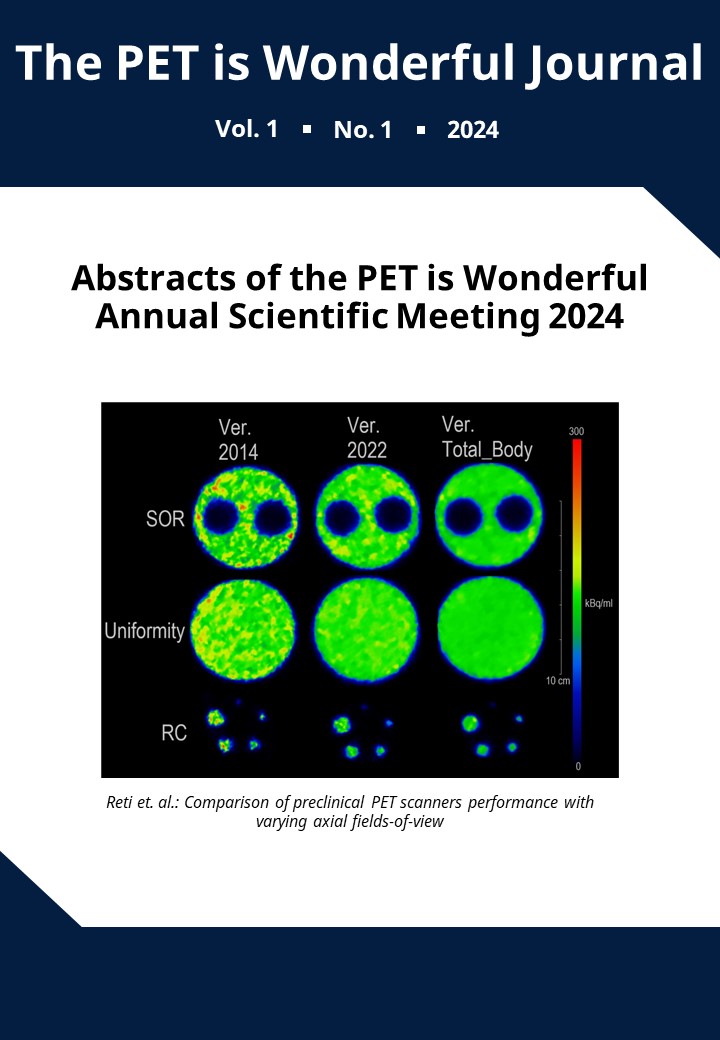Assessing overall oxidative metabolism of high-metabolic-rate abdominal organs in diet-induced obesity using compartmental modeling of [11C]acetate-PET
DOI:
https://doi.org/10.2218/piwjournal.9819Abstract
[11C]Acetate PET imaging is a powerful tool for visualizing and studying metabolic processes in various tissues and organs, particularly in the context of heart disease and prostate cancer. The tracer can reflect tissue perfusion, oxidative metabolism, and fatty acid synthesis[1].
Male Sprague Dawley rats on standard (SD n=6) and after 8-10 weeks on a high-fat diet (HFD n=6) were studied for [11C]acetate turnover. Longitudinal utilization of the tracer in the abdomen was recorded using Siemens Inveon µ-PET/CT. Under isoflurane anesthesia, rats underwent 60 min dynamic [11C]acetate-PET scans and additionally on the next week venous blood sampling for [11C]CO2-metabolite analysis (7-time points; SD n=3; HFD n=3) accordingly[2]. Delineation of kidneys, myocardium and liver; SUV calculations; 1-tissue compartmental modeling with blood-to-plasma ratio and [11C]CO2-metabolite correction were performed in PMOD3.8; clearance rate was calculated in Carimas2.1.
Semi-quantification methods demonstrated contrasting outcomes between the groups. Increased renal (right p=0.04, left p=0.03) and myocardial (p=0.01) uptake (Fig.A) was observed in the HFD group, while clearance rates in kidneys (right p=0.01, left p=0.04) and liver (p=0.03) were decreased (Fig.B). Blood sampling for [11C]CO2-metabolite analysis revealed differing profiles between the groups, with a maximum peak at 30 min in SD and two peaks at 5 and 40 min in HFD animals (Fig.C). Deeper analysis using 1-tissue compartmental modeling shed light on the hepatic uptake and showed a difference in the volume of distribution (Vt), which was significantly decreased in the HFD group (p<0.001) (Fig.D).
The study indicates [11C]acetate accumulation in metabolically active organs: kidneys, heart, and liver. Compartmental modeling demonstrated the necessity of metabolite correction for quantitative analysis. Previously, Sprague Dawley rats on HFD were studied for fatty acid uptake and decline of VLDL synthesis[3] that can correlate with the variation of Vt in the liver and confirm pathological changes in organ functioning.
Please click on the 'PDF' for the full abstract!
Downloads
Published
Issue
Section
License
Copyright (c) 2024 Usevalad Ustsinau, Marius Ozenil , Antonia Grosinger, Thomas Wanek, Markus Hacker, Martin Krššák, Cecile Philippe

This work is licensed under a Creative Commons Attribution 4.0 International License.





